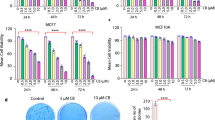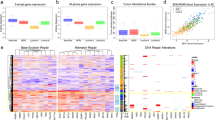Abstract
Gene amplification drives oncogenesis in a broad spectrum of cancers. A number of drugs have been developed to inhibit the protein products of amplified driver genes, but their clinical efficacy is often hampered by drug resistance. Here, we introduce a therapeutic strategy for targeting cancer-associated gene amplifications by activating the DNA damage response with triplex-forming oligonucleotides (TFOs), which drive the induction of apoptosis in tumors, whereas cells without amplifications process lower levels of DNA damage. Focusing on cancers driven by HER2 amplification, we find that TFOs targeting HER2 induce copy number-dependent DNA double-strand breaks (DSBs) and activate p53-independent apoptosis in HER2-positive cancer cells and human tumor xenografts via a mechanism that is independent of HER2 cellular function. This strategy has demonstrated in vivo efficacy comparable to that of current precision medicines and provided a feasible alternative to combat drug resistance in HER2-positive breast and ovarian cancer models. These findings offer a general strategy for targeting tumors with amplified genomic loci.
This is a preview of subscription content, access via your institution
Access options
Access Nature and 54 other Nature Portfolio journals
Get Nature+, our best-value online-access subscription
$29.99 / 30 days
cancel any time
Subscribe to this journal
Receive 12 print issues and online access
$209.00 per year
only $17.42 per issue
Buy this article
- Purchase on Springer Link
- Instant access to full article PDF
Prices may be subject to local taxes which are calculated during checkout






Similar content being viewed by others
Data availability
The authors declare that the data supporting the findings of this study are available within the paper and its Supplementary Information. Source data are provided with this paper.
References
Chen, Y. et al. Identification of druggable cancer driver genes amplified across TCGA datasets. PLoS ONE 9, e98293 (2014).
Matsui, A., Ihara, T., Suda, H., Mikami, H. & Semba, K. Gene amplification: mechanisms and involvement in cancer. Biomol. Concepts 4, 567–582 (2013).
Santarius, T., Shipley, J., Brewer, D., Stratton, M. R. & Cooper, C. S. A census of amplified and overexpressed human cancer genes. Nat. Rev. Cancer 10, 59–64 (2010).
Albertson, D. G. Gene amplification in cancer. Trends Genet. 22, 447–455 (2006).
Ohshima, K. et al. Integrated analysis of gene expression and copy number identified potential cancer driver genes with amplification-dependent overexpression in 1,454 solid tumors. Sci. Rep. 7, 641 (2017).
Moasser, M. M. & Krop, I. E. The evolving landscape of HER2 targeting in breast cancer. JAMA Oncol. 1, 1154–1161 (2015).
Slamon, D. J. et al. Studies of the HER-2/neu proto-oncogene in human breast and ovarian cancer. Science 244, 707–712 (1989).
Baselga, J., Albanell, J., Molina, M. A. & Arribas, J. Mechanism of action of trastuzumab and scientific update. Semin. Oncol. 28, 4–11 (2001).
Swain, S. M. et al. Pertuzumab, trastuzumab, and docetaxel in HER2-positive metastatic breast cancer. N. Engl. J. Med. 372, 724–734 (2015).
Wilks, S. T. Potential of overcoming resistance to HER2-targeted therapies through the PI3K/Akt/mTOR pathway. Breast 24, 548–555 (2015).
Petty, R. D. et al. Gefitinib and EGFR gene copy number aberrations in esophageal cancer. J. Clin. Oncol. 35, 2279–2287 (2017).
Pao, W. et al. Acquired resistance of lung adenocarcinomas to gefitinib or erlotinib is associated with a second mutation in the EGFR kinase domain. PLoS Med. 2, e73 (2005).
Ricciardi, A. S., McNeer, N. A., Anandalingam, K. K., Saltzman, W. M. & Glazer, P. M. Targeted genome modification via triple helix formation. Methods Mol. Biol. 1176, 89–106 (2014).
Gaddis, S. S. et al. A web-based search engine for triplex-forming oligonucleotide target sequences. Oligonucleotides 16, 196–201 (2006).
Ebbinghaus, S. W. et al. Triplex formation inhibits HER-2/neu transcription in vitro. J. Clin. Invest. 92, 2433–2439 (1993).
Kaushik Tiwari, M. & Rogers, F. A. XPD-dependent activation of apoptosis in response to triplex-induced DNA damage. Nucleic Acids Res. 41, 8979–8994 (2013).
Kaushik Tiwari, M., Adaku, N., Peart, N. & Rogers, F. A. Triplex structures induce DNA double strand breaks via replication fork collapse in NER deficient cells. Nucleic Acids Res. 44, 7742–7754 (2016).
Rogers, F. A., Vasquez, K. M., Egholm, M. & Glazer, P. M. Site-directed recombination via bifunctional PNA–DNA conjugates. Proc. Natl Acad. Sci. USA 99, 16695–16700 (2002).
Wang, G., Seidman, M. M. & Glazer, P. M. Mutagenesis in mammalian cells induced by triple helix formation and transcription-coupled repair. Science 271, 802–805 (1996).
Szollosi, J., Balazs, M., Feuerstein, B. G., Benz, C. C. & Waldman, F. M. ERBB-2 (HER2/neu) gene copy number, p185HER-2 overexpression, and intratumor heterogeneity in human breast cancer. Cancer Res. 55, 5400–5407 (1995).
Vergote, I. et al. Neoadjuvant chemotherapy or primary surgery in stage IIIC or IV ovarian cancer. N. Engl. J. Med. 363, 943–953 (2010).
Jenjaroenpun, P. & Kuznetsov, V. A. TTS mapping: integrative WEB tool for analysis of triplex formation target DNA sequences, G-quadruplets and non-protein coding regulatory DNA elements in the human genome. BMC Genomics 10, S9 (2009).
Cook, P. J. et al. Tyrosine dephosphorylation of H2AX modulates apoptosis and survival decisions. Nature 458, 591–596 (2009).
zum Buschenfelde, C. M., Hermann, C., Schmidt, B., Peschel, C. & Bernhard, H. Antihuman epidermal growth factor receptor 2 (HER2) monoclonal antibody trastuzumab enhances cytolytic activity of class I-restricted HER2-specific T lymphocytes against HER2-overexpressing tumor cells. Cancer Res. 62, 2244–2247 (2002).
Cuello, M. et al. Down-regulation of the erbB-2 receptor by trastuzumab (Herceptin) enhances tumor necrosis factor-related apoptosis-inducing ligand-mediated apoptosis in breast and ovarian cancer cell lines that overexpress erbB-2. Cancer Res. 61, 4892–4900 (2001).
Deng, Y. et al. The effect of hyperbranched polyglycerol coatings on drug delivery using degradable polymer nanoparticles. Biomaterials 35, 6595–6602 (2014).
Bindra, R. S. & Glazer, P. M. Repression of RAD51 gene expression by E2F4/p130 complexes in hypoxia. Oncogene 26, 2048–2057 (2007).
Balashanmugam, M. V. et al. Preparation and characterization of novel PBAE/PLGA polymer blend microparticles for DNA vaccine delivery. ScientificWorldJournal 2014, 385135 (2014).
Seo, Y. E. et al. Nanoparticle-mediated intratumoral inhibition of miR-21 for improved survival in glioblastoma. Biomaterials 201, 87–98 (2019).
Oeck, S. et al. The Focinator v2-0—graphical interface, four channels, colocalization analysis and cell phase identification. Radiat. Res. 188, 114–120 (2017).
Oeck, S., Malewicz, N. M., Hurst, S., Rudner, J. & Jendrossek, V. The Focinator—a new open-source tool for high-throughput foci evaluation of DNA damage. Radiat. Oncol. 10, 163 (2015).
Mandl, H. K. et al. Optimizing biodegradable nanoparticle size for tissue-specific delivery. J. Control. Release 314, 92–101 (2019).
Acknowledgements
This work was supported by grants from the National Cancer Institute (NCI) of the National Institutes of Health (NIH) R21CA185192 to F.A.R., the Breast Cancer Alliance Exceptional Project Grant to F.A.R., National Institute of General Medical Sciences R01GM126211 to F.A.R. and NIH R01CA149128 to W.M.S. E.Q. was supported by training grants T32GM07205 and 5T32GM007223-43.
Author information
Authors and Affiliations
Contributions
F.A.R. conceived and designed the study, contributed to completion of experiments and wrote the manuscript. M.K.T. contributed to study design and conducted the majority of the research. D.A.C.-R. performed studies to evaluate TFOs targeting introns of the HER2 gene and studies to evaluate mechanism of action. H.C.R.T. performed tumor growth delay studies in the orthotopic mouse model for breast cancer, immunofluorescence of tumor tissue and transcription inhibition studies. Y.L. performed the tumor growth delay studies in mouse models for breast and ovarian cancers. E.Q. generated and characterized NPs. A.K. contributed to the analysis of confocal microscopy images and quantification of immunofluorescence images. C.C. contributed to DNA damage and apoptosis experiments in ovarian cancer cell lines. E.S. contributed to TFO tumor uptake studies. D.T.B. conducted pathology analysis of tumor xenograft samples. H.W.S. and W.M.S. assisted with NP technology.
Corresponding author
Ethics declarations
Competing interests
Yale University has filed patent applications related to this work (inventor F.A.R.).
Additional information
Peer review information Nature Biotechnology thanks Carlo V. Catapano and the other, anonymous, reviewer(s) for their contribution to the peer review of this work.
Publisher’s note Springer Nature remains neutral with regard to jurisdictional claims in published maps and institutional affiliations.
Extended data
Extended Data Fig. 1 Experiments Supporting Main Fig. 2.
(a) Representative images of neutral comet assays performed 24 h after HER2-205 treatment in MCF7 and BT474 cells (scale bars, 200μm). (b) Quantification of cells with greater than 5 γH2AX and/or 53BP1 foci per nuclei in BT474 cells treated with HER2-205 or MIX24 (mean ± SD; two-way ANOVA with Tukey test post-hoc; ****P < 0.0001, **P < 0.01; 50 cells per sample, n = 2 independent experiments). (c) Triplex formation induces apoptosis in HER2-positive breast cancer cell lines as measured by Western blot analysis of cleaved PARP (n = 3 independent experiments). (d) Detection of HER2 copies in interphase nuclei by dual color FISH with HER2 probe (red) and chromosome 17 probe (green), scale bars, 2.5 μm. (e) Immunofluorescence of γH2AX in PE01 ovarian cancer cells 24 h post-treatment with HER2-205 or MIX24 (scale bars, 5 μm). (f) Representative immunofluorescence images of γH2AX foci in SKOV3 ovarian cancer cells 24 h following treatment with HER2-205 or MIX24 (scale bars, 2.5 μm). (g) Frequency of PE01 and SKOV3 cells positive for γH2AX following 24 h treatment (mean ± SD; two-way ANOVA with Tukey test post-hoc; ***P < 0.001, **P < 0.01; 50 cells per sample, n = 2 independent experiments). (h) Quantification of triplex-induced DNA double strand breaks using the neutral comet assay as measured by tail moment (mean ± SEM; two-way ANOVA with Tukey test post-hoc, ****P < 0.0001; n = 150 comets). (i) Monolayer growth assay demonstrates a decrease in cell survival in PE01 and SKOV3 cells treated with HER2-205 72 h after treatment. (j) Western blot analysis of activation of apoptosis as measured by cleaved PARP in ovarian cancer cells following TFO treatment (n = 3 independent experiments).
Extended Data Fig. 2 Experiments Supporting Main Fig. 5.
(a) ChIP analysis of γH2AX in BT474 cells detected increased DNA damage at the targeted HER2 gene following HER2-5922 treatment. Data are presented as mean ± SEM and analyzed by two-way ANOVA with Tukey test post-hoc, ***P < 0.001, n = 3 independent experiments. (b) Quantification of phosphorylated ATM by flow cytometry following treatment with HER2-205. Data are presented as mean ± SEM and analyzed by one-way ANOVA with Tukey test post-hoc, *P < 0.05, n = 3 independent experiments. (c) Analysis of HER2 gene expression by RT-PCR 12 h post-treatment with HER2-targeted TFOs (mean ± SD; two-ANOVA with Tukey test post-hoc; ns, not significant; n = 3 independent experiments). (d) Quantification of triplex-induced DNA double strand breaks using the neutral comet assay as measured by tail moment 12 h post TFO treatment (mean ± SEM; one-ANOVA with Tukey test post-hoc; ****P < 0.0001; n = 3 independent experiments). (e) Western blot analysis of activation of apoptosis as measured by cleaved PARP and pH2AX Y142 12 h following TFO treatment (representative immunoblots, n = 2 independent experiments). Western blot analysis of the phosphorylation status of HER family receptors (f) HER3, (g) HER4, and (h) EGFR (HER1) in multiple breast cancer cell lines following HER2-205 treatment (representative immunoblots, n = 2). (i) Analysis of HER2 gene expression by RT-PCR 12 h post-treatment with HER2-targeted TFOs (mean ± SEM; one-way ANOVA with Tukey test post-hoc; ns, not significant; n = 3 independent experiments). (j) Analysis of HER2 gene expression by RT-PCR 20 h following pretreatment with the transcription inhibitor, α-amanitin (mean ± SD; one-way ANOVA with Tukey test post-hoc; ****P < 0.0001; n = 4 experiments).
Extended Data Fig. 3 Biodistribution of nanoparticle formulations.
Comparison of PLGA and PLA-HPG NPs in vivo. (a) Uptake of DiD-loaded NPs, PLGA/DCM, PLGA/EtOAc and PLA-HPG, 12 h after systemic administration via retro-orbital injection. Tumor cryosections visualize DAPI (blue) and DiD (red) (scale bars, 50 μm; n = 2 tumors). (b) Biodistribution of DiD-loaded PLA-HPG NPs 12 h after systemic administration. DiD fluorescence in isolated organs after retro-orbital injection with DiD encapsulated NPs (2 mg). Cryosections visualize DAPI (blue) and DiD (red) (scale bars, 50 μm; n = 2 animals).
Extended Data Fig. 4 Experiments Supporting Main Fig. 6.
Biodistribution of TAMRA-HER2-205 encapsulated PLA-HPG nanoparticles (NPs). (a) Representative confocal images of tissue sections 12 hours post intravenous administration via retro-orbital injection of a 2 mg dose of NPs (scale bars, 50 μm). (b) Representative confocal images of TAMRA-HER2-205 biodistribution in tissues 24 hours post treatment (scale bars, 50 μm). (c) TAMRA fluorescence was quantified at both 12 and 24 hours after dosing (2 mg of NPs) and TFO uptake in each tissue is reported as mean fluorescence intensity (MFI) (mean ± SEM, n = 2 mice). Statistical significance was calculated by one-way ANOVA and Kruskal-Wallis test (****P < 0.0001, **P < 0.01). (d) Analysis of TAMRA-HER2-205 biodistribution 12 h post treatment. Fluorescence intensity observed in each tissue is reported as a percentage of the combined total fluorescence intensity detected in spleen, kidney, liver and tumor (tumor data is shown and quantified in Fig. 6a,b). Total area of the pie chart denotes the sum of the absolute fluorescence within the four organs, representing the total TFO uptake by these organs, and each slice gives the relative HER2-205 uptake for each organ. (e) Analysis of TAMRA-HER2-205 biodistribution 24 h post systemic administration. Fluorescence intensity observed in each tissue is reported as a percentage of the combined total fluorescence intensity detected in spleen, kidney, liver and tumor (tumor data is shown and quantified in Fig. 6a,b). Total area of the pie chart denotes the sum of the absolute fluorescence within the four organs, representing the total TFO uptake by these organs, and each slice gives the relative HER2-205 uptake for each organ.
Extended Data Fig. 5 Experiments Supporting Main Fig. 6.
(a) Nanoparticle Characterization. Nanoparticle diameter as measured by dynamic light scattering. Nanoparticle surface charge measured by zeta potential. Nanoparticle loading of TFOs measured by extraction and analysis. All data is plotted as mean ± SEM, n = 3 experiments. (b) Representative images of confocal microscopy of γH2AX immunofluorescence in tumors 24 h post-treatment with HER2-205 PLA-HPG NPs and quantification of γH2AX foci is reported as mean fluorescence intensity (MFI) (mean ± SEM; Kolmogorov-Smirnov test; ***P < 0.001, **P < 0.01; n = 4 tumors/timepoint; scale bars, 10μm). (c) Representative images of confocal microscopy of cleaved caspase 3 immunofluorescence in tumors 12 h post-treatment with HER2-205 PLA-HPG NPs and quantification of activated caspase 3 is reported as mean fluorescence intensity (mean ± SEM; Kolmogorov-Smirnov test; ****P < 0.0001; n = 4 tumors/timepoint; scale bars, 10μm). (d) HER2 immunofluorescence analysis of BT474 tumor sections from mice 12 h and 24 h after treatment with a single dose of HER2-205 PLA-HPG NPs (2 mg). Data represented as mean ± SEM and analyzed by one-way ANOVA Kruskal-Wallis test (n = 4 tumors/time point; ns, not significant). Scale bar, 10μm. (e) Confocal microscopy images of tumor sections analyzed by immunofluorescence 12 h and 24 h following a single dose of TAMRA-HER2-205 PLA-HPG NPs (scale bars, 10μm).
Extended Data Fig. 6 ESI-MS and HPLC characterization of TFOs.
(a) Analytical ESI-MS spectrum of HER2-205. (b) Analytical reverse-phased HPLC of HER2-205. (c) Analytical ESI-MS spectrum of HER2-5922. (d) Analytical reverse-phased HPLC of HER2-5922.
Extended Data Fig. 7 Flow cytometry profiles.
A single cell homogeneous population was utilized for FCS/SSC gating of the starting cell population. (a) Flow cytometry profiles of BT474 cells stained for Annexin V-FITC/PI to measure apoptotic cells. Cells were harvested 24 h after treatment. Lower right quadrant represents the combined percentage of early and late apoptotic cells. (b) Flow cytometry profiles of BT474 cells stained for pATM. Cells were harvested 24 h after treatment. The box indicates the gate for high levels of pATM and numbers represent percentage of cells with high levels of pATM.
Supplementary information
Source data
Source Data Fig. 1
Unprocessed western blots and/or gels.
Source Data Fig. 4
Unprocessed western blots and/or gels.
Source Data Fig. 5
Unprocessed western blots and/or gels.
Source Data Extended Data Fig. 1
Unprocessed western blots and/or gels.
Source Data Extended Data Fig. 2
Unprocessed western blots and/or gels.
Rights and permissions
About this article
Cite this article
Kaushik Tiwari, M., Colon-Rios, D.A., Tumu, H.C.R. et al. Direct targeting of amplified gene loci for proapoptotic anticancer therapy. Nat Biotechnol 40, 325–334 (2022). https://doi.org/10.1038/s41587-021-01057-5
Received:
Accepted:
Published:
Issue Date:
DOI: https://doi.org/10.1038/s41587-021-01057-5
This article is cited by
-
Nanoparticle delivery of TFOs is a novel targeted therapy for HER2 amplified breast cancer
BMC Cancer (2023)
-
Amplifying targeting
Nature Reviews Cancer (2022)



